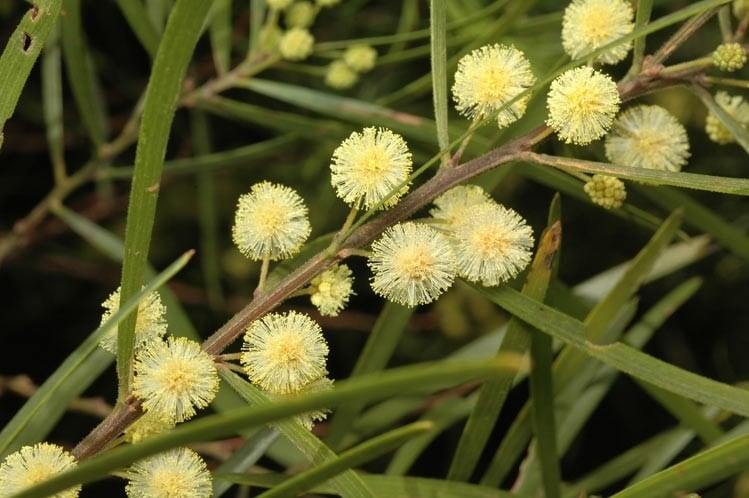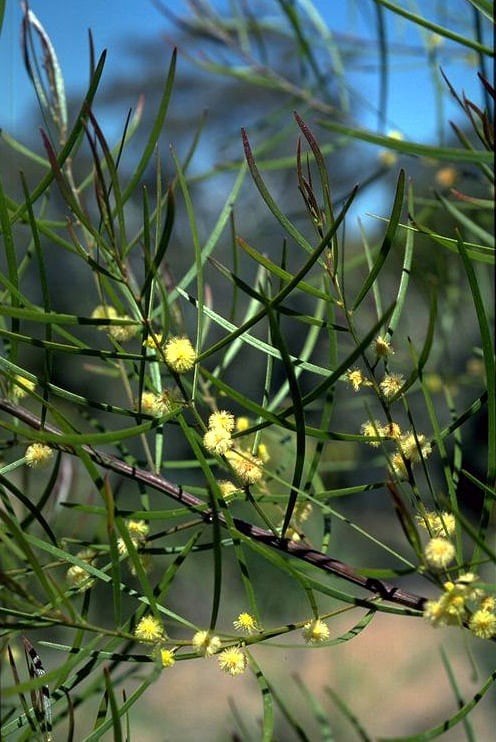Acacia viscidula Benth.
WATTLE
Acacias of Australia
Common Name
Sticky Wattle
Family
Fabaceae
Distribution
Occurs principally in the Darling Downs in south-eastern Qld and adjacent N.S.W., extending inland in Qld to the Injune area and in N.S.W. to the Coonabarabran area.
Description
Shrub or small tree 1–6 m high. Branchlets angular, ribbed, ±resinous, with ±sparse, short, spreading hairs, occasionally glabrous. Phyllodes ascending, linear, ±incurved, (4–) 5–9 (–11) cm long, 1–3 mm wide, curved-acute to mucronate or apiculate, usually innocuous, thin, ±puberulous or glabrous, with 3–7 distant, impressed, ±resinous nerves and occasional anastomoses. Inflorescences simple, 1 or 2 per axil; peduncles 2–6 mm long, ±puberulous; heads globular, 4–5.5 mm diam., 15–35-flowered, light golden. Flowers 4-merous, infrequently 5-merous; sepals free to 1/2‑united. Pods linear, raised over seeds, ±7.5 cm long, 2–3 mm wide, ±puberulous. Seeds longitudinal, oblong, ±4 mm long, glossy, dark brown; aril terminal.
Habitat
Found in upland granitic soils, in low woodland with Acacia and Eucalyptus species.
Specimens
Qld: 22 km SSE of Stanthorpe, 5 km N of Girraween Natl Park, R.S. & R.A.Cowan A-788 (BRI, CANB, K, MEL, NSW, PERTH). N.S.W.: 8 km WNW of Stannum towards Torrington, R.Coveny 2257 (NSW); [Coonabarabran area] near Backwater [Ck], 30 Oct. 1929, E.McKie & T.Youman (NSW).
Notes
Similar in general appearance to A. cognata and A. subporosa, but probably most closely related to species of the ‘A. wilhelmiana group’. Possibly related to A. elongata, but differing in having predominantly tetramerous flowers, at least in all the material I have seen, including the type. The species is described as ‘mostly 5-merous, but often 4-merous’ by G.Bentham, Fl. Austral. 2: 387 (1864).
A variant from the vicinity of Torrington (e.g. R.Coveny 2257, NSW, PERTH) is not included in the above description because its taxonomic status needs to be assessed. It has the general facies of A. viscidula but differs most obviously in its densely puberulous-tomentulose branchlets and peduncles and its phyllodes which are 4–6 (–7) cm long, somewhat rigid and ±pungent.
Bentham’s variety angustifolia, for which he cited no specimens, is said to be a narrow phyllode form with smaller flower-heads but the measurements given in his description fall well within the limits of the species for these characters. I have seen specimens (e.g. J.L.Boorman, NSW222567) from the Stanthorpe area of Qld that fit Bentham’s description but neither I nor L.Pedley, Austrobaileya 1: 204 (1978), have been able to locate authentic material.
FOA Reference
Data derived from Flora of Australia Volumes 11A (2001), 11B (2001) and 12 (1998), products of ABRS, ©Commonwealth of Australia
Author
R.S.Cowan
This identification key and fact sheets are available as a mobile application:
URL: https://apps.lucidcentral.org/wattle/
© Copyright 2018. All rights reserved.













